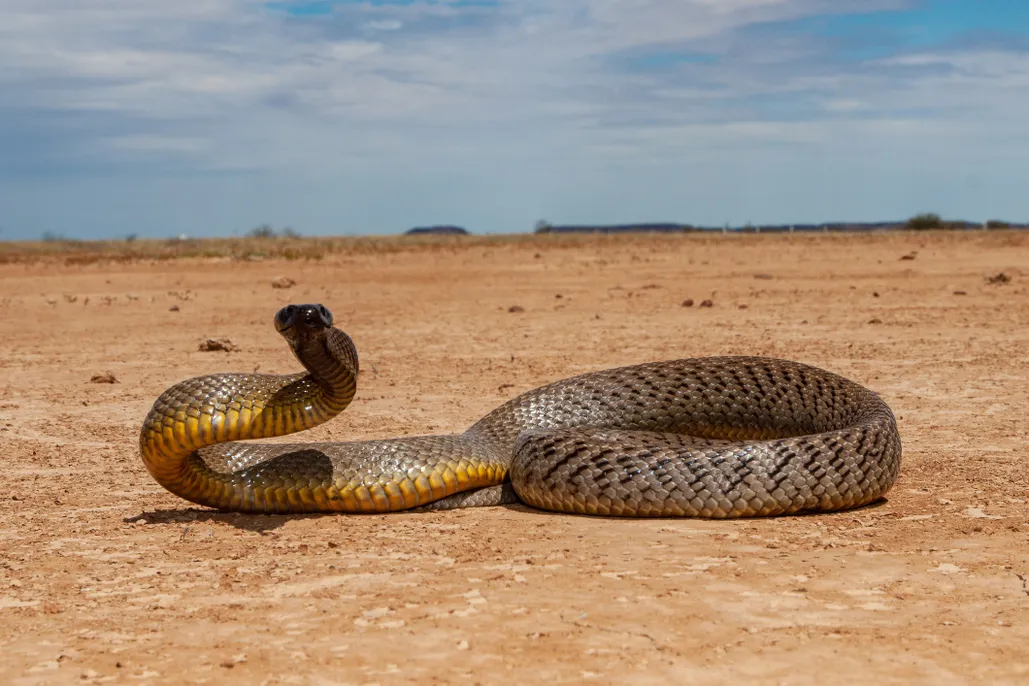Welcome to BungeeCity.com, where we dive headfirst into the fascinating world of snake predators! Have you ever wondered what creatures dare to challenge these slithery serpents? Prepare to be amazed as we unveil the top 12 snake predators that will leave you hissing with astonishment.
Snakes may be renowned for their stealth and cunning, but they are not invincible. In nature’s grand game of cat and mouse, or rather snake and mongoose, there are some formidable opponents that give these reptiles a run for their money. From the wild antics of bobcats to the tenacious spirit of honey badgers, we explore the diverse range of creatures that have mastered the art of snake hunting.
But it doesn’t stop there! We’ll also take a peek into different habitats and reveal the specific predators that slither and stalk in each unique environment. Whether it’s the crocodiles lurking in the murky swamps or the elegant hawks soaring through the skies, the battle between predator and prey is a constant dance of survival.
And just when you thought you knew it all, we’ll throw in a delightful twist. Discover some unexpected animals that have developed a taste for these legless wonders. Who knew that hedgehogs and opossums could give snakes a run for their money? It’s a jungle out there, and the food chain is full of surprises!
So, grab your curiosity and get ready for a wild ride as we unravel the secrets of snake predators. From the stealthy to the fierce, these top 12 contenders will have you on the edge of your seat. Join us on this thrilling adventure and let’s uncover what eats snakes in the most unexpected ways. Let the predator-prey dance begin!
Unraveling the Food Chain: Top 12 Snake Predators
Often feared for their potent venom and disconcerting slither, snakes are not the invincible creatures some may perceive them to be. These cold-blooded reptiles are not the apex predators of the animal kingdom. Indeed, they are part of a complex and diverse food web, falling prey to a multitude of hunters in the wild. Let’s take a journey into the world of snake predators, shedding light on the surprising range of creatures that consider snakes a delicacy.
| Snake Predator | Habitat | Method of Hunting |
|---|---|---|
| Bobcats | North America | Ambush Predation |
| Mongooses | Africa, southern Asia, and southern Europe | Attack on head and neck |
| Wolverines | Northern Hemisphere | Aggressive Predation |
| Crocodiles | Africa, Australia, Asia, and the Americas | Capture in jaws and death roll |
| Hedgehogs | Europe, Asia, and Africa | Immunity to venom and consumption |
| Opossums | North America | Immunity to venom and consumption |
| Alligators | Southeastern US and China | Powerful bite and swallowing |
| Hawks | Worldwide | Aerial swoop and talons |
| Secretary Birds | Sub-Saharan Africa | Stomping on snake’s head |
| King Cobra | India and Southeast Asia | Venomous bite |
| Honey Badgers | Africa, Western Asia, and Indian Subcontinent | Immunity to venom and consumption |
| Tigers | Asia | Powerful bite and claws |
This table provides a snapshot of the top predators of snakes, their habitats, and their unique hunting methods. From the agile bobcats of North America to the fearless honey badgers of Africa, each of these predators has its own distinctive approach to hunting and consuming snakes. Some, like the mangoose and the hedgehog, are even immune to snake venom, making them particularly formidable opponents.
What’s more, some of these predators are also known to eat snakes, such as the king cobra, a snake itself. It’s a startling reminder of the intricate and often brutal realities of the wild. But remember, this is not a comprehensive list. The natural world is full of surprises, and there are plenty more snake predators waiting to be discovered.
1. Bobcats: The Furry Defenders
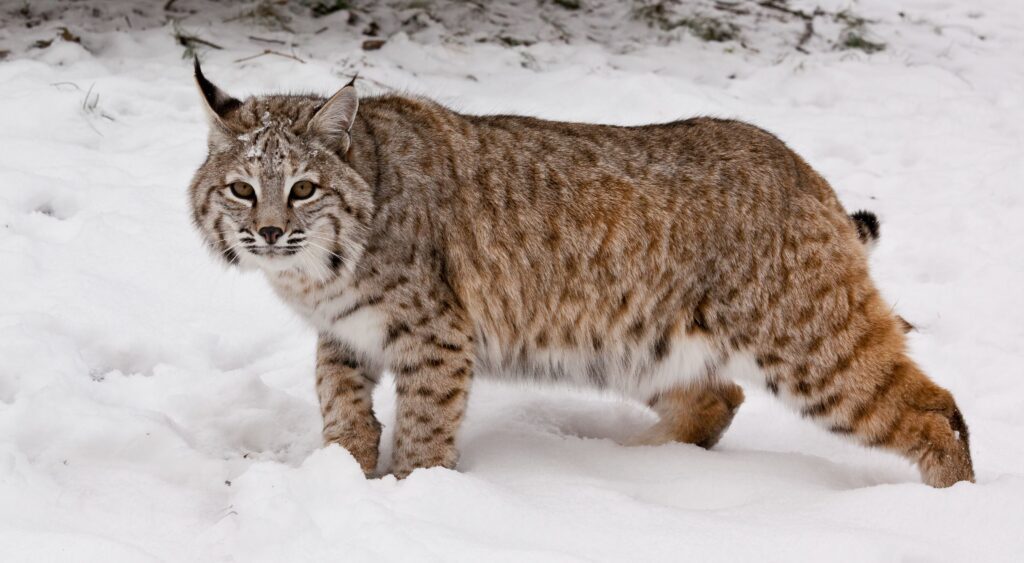
bobcat
When it comes to the wild, there are few sights as captivating as the bobcat in action. These medium-sized wild felines, indigenous to North America, are hailed for their hunting prowess. But what truly sets them apart in the food chain is their curious relationship with snakes.
Imagine a bobcat, its fur glistening under the sun, stealthily stalking its prey in the wilderness. Suddenly, a snake slithers across its path. Rather than retreating, the bobcat sees an opportunity for a meal. As it inches closer, its keen eyes, always on the lookout, spot the snake’s movements. Its sharp sense of smell, a trait honed by evolution, confirms the identity of its target.
But how does a creature like a bobcat, with no venom immunity, take on a venomous snake?
The answer lies in their unique defense mechanism. Bobcats are blessed with a thick, furry coat that acts as an armor. This coat is not just for aesthetics; it’s their first line of defense against snake attacks. The dense fur makes it exceedingly difficult for a snake to latch onto the bobcat and deliver a successful venom injection. This is nature’s own Kevlar.
Moreover, the bobcat’s natural agility and lightning-quick reflexes allow it to dodge any sudden strikes, making it a formidable opponent for snakes. This combination of physical traits and honed instincts makes the bobcat one of the top ophiophagus – a term denoting animals that include snakes in their diet.
So, the next time you envision a bobcat, remember, it’s not just a wild cat, but a fierce hunter that bravely takes on snakes, turning them from feared predators into prey.
2. The Fearless Foes: Mongooses
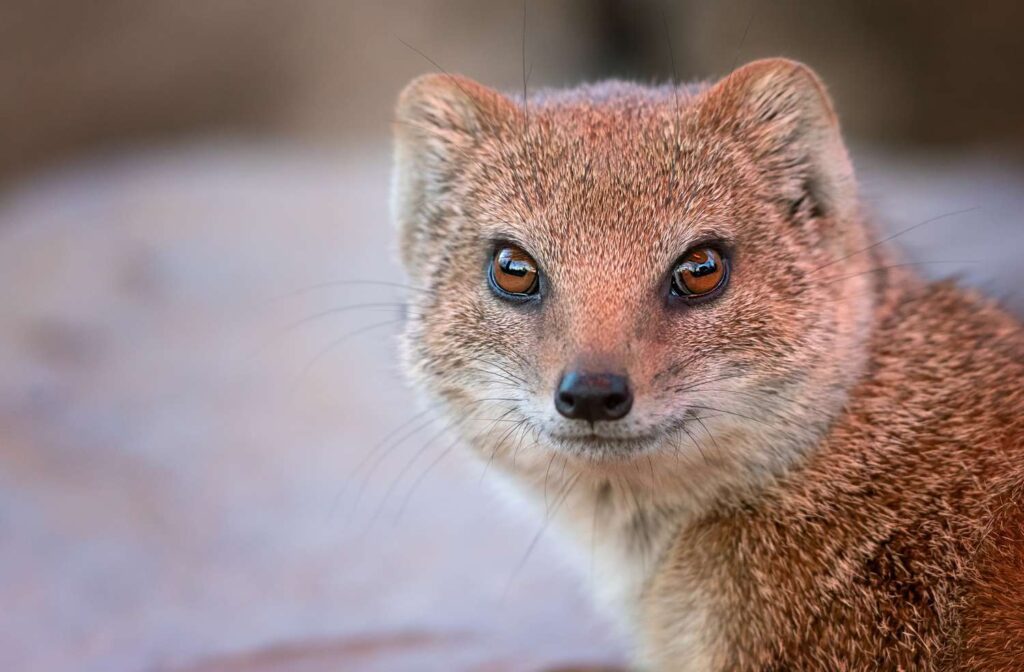
mongoos
Picture a sun-soaked savannah in the heart of Africa, the stillness of the day shattered by an epic clash of predator and prey. The antagonists? A venomous snake and a small yet audacious creature known as the mongoose. This scene is not uncommon in the wild territories of Asia, Europe, and Africa, where mongooses have earned their reputation as formidable snake hunters.
What sets the mongoose apart in the animal kingdom is not merely its agility or fearlessness, but an exceptional biological advantage. This audacious creature is immune to snake venom, making it one of nature’s premier snake predators. When a venomous snake strikes, its potent toxins cause little to no harm to the mongoose, turning what could be a lethal encounter into a skewed battle in favor of the mongoose. This immunity acts as an extraordinary shield, allowing the mongoose to take on venomous snakes that other predators might avoid.
Despite their relatively small size, mongooses are well-equipped to handle snake attacks. They’re agile creatures, capable of dodging quick strikes with an uncanny knack. But when the fight gets down to the wire, it’s their venom immunity that gives them the upper hand – a trait that truly underscores their status as one of the top snake predators.
So, the next time you find yourself marvelling at the complexities of the food chain, remember the mongoose – a small creature with a big heart that doesn’t hesitate to take on opponents many times their size. Truly, when it comes to the question, “What eats snakes?“, the mongoose stands as a testament to the saying that size isn’t everything.
3. The Ferocious Wolverines
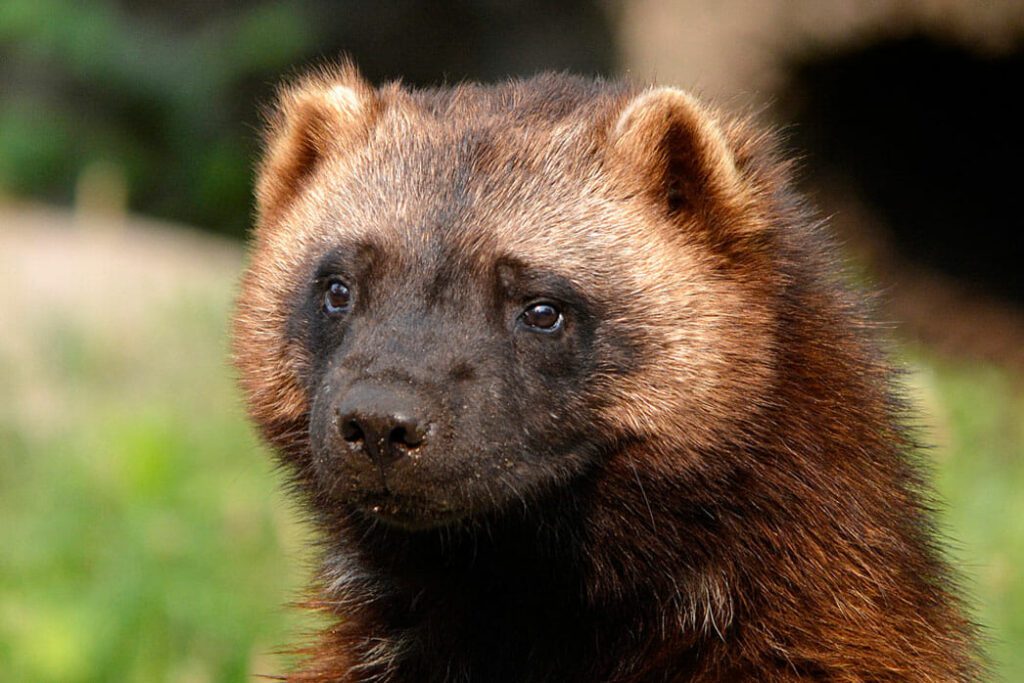
wolverine
Emerging from the shadows of the diverse terrains of Europe, North America, and Asia, the wolverines stand as an unexpected yet fierce adversary to snakes. Their compact, muscular bodies belie their raw strength and predatory prowess, making them one of the snake’s most formidable foes.
Wolverines are not typically the first creature that comes to mind when one thinks of snake predators. This underdog status, however, only adds to their mystique and the awe they inspire. These robust creatures, despite their relative size, are capable of executing deadly attacks on snakes, often leaving their adversaries little chance of survival.
“Wolverines kill snakes by either biting them in half or crushing them with their powerful jaws.”
This chilling fact underscores the sheer strength and ruthlessness that characterize wolverines. These creatures are not deterred by the reputation snakes hold as dangerous predators. Instead, they confront them head-on, seizing them in their mighty jaws, and often, biting them in half. Their powerful jaws can also crush snakes, effectively neutralizing the threat they pose.
The wolverines‘ prowess is not limited to their jaw strength alone. They are also known for their tenacity and fearlessness, traits that make them an intimidating adversary, even for venomous snakes. So, the next time you envision a snake predator, remember the mighty wolverine – a testament to the fact that strength and courage often come in the most unexpected packages.
4. Crocodiles
Emerging from the murky waters and instilling fear with their mere presence, we have the formidable predators of the reptilian world – Crocodiles. Armed with one of nature’s most deadly weapons, their powerful jaws, crocodiles are a menacing adversary for snakes.
These behemoth reptiles, with their prehistoric appearance, can be found lurking in the warm tropical waters of Africa, Australia, Asia, and the Americas. The crocodile’s thick, rugged skin serves as a shield, protecting them from the potentially deadly poison of snake bites. This biological advantage transforms these reptiles into fearless hunters, unphased and unaffected by venomous snakes that would pose a threat to many other predators.
“Crocodiles are notorious for their deadly jaws, capable of crushing a snake’s body with unmatchable force or simply swallowing the snake whole.”
The sight of a crocodile leisurely swimming with a snake dangling from its mouth paints a vivid picture of their dominance in the food chain. Their seemingly effortless ability to make a meal out of snakes underscores their reputation as formidable snake predators.
Regardless of the snake’s size or venomous capabilities, crocodiles exhibit a ruthless predatory instinct, turning these slithering reptiles from feared predators into helpless prey. So next time you spot a crocodile basking in the sun, remember – beneath that still exterior lies a fearless snake predator.
5. Hedgehogs
The animal kingdom is teeming with unexpected heroes, and in the world of snake predators, the humble Hedgehog is an unsung champion. Seemingly harmless, these charming creatures are armed with a unique set of tools that make them a formidable opponent against any snake.
The Hedgehog’s primary weapon is its coat of pointed spines, a natural armor that provides a near-impervious defense against snake bites. Each spine, or quill, is a hollow hair stiffened by keratin, the same protein that strengthens our human nails. This defensive barrier is not just a passive mechanism; when threatened, a hedgehog can roll into a tight ball, presenting the snake with an impenetrable ball of spikes.
But don’t let their cute and prickly exterior fool you. These creatures are more than just their defensive armor. They are active hunters, using their keen sense of smell and hearing to locate their snake prey. Their small, sharp teeth are perfect for biting into the soft flesh of a snake, and their natural immunity to many snake venoms gives them an edge in these deadly encounters.
Erinaceus europaeus, the European hedgehog, is particularly well-known for its snake hunting prowess. They have been observed attacking adders, a type of venomous snake found across Europe, with surprising agility and fearlessness. It’s a dance of life and death, as the hedgehog maneuvers around the snake, waiting for the perfect moment to strike.
In this riveting contest of nature, the hedgehog stands as a testament to the fact that size and strength are not the only determining factors in the predator-prey relationship. Their adaptation and resilience, their pointed spines providing a perfect defense, and their fearlessness make them an unlikely but effective snake predator. So, the next time you see a hedgehog, remember, behind that adorable facade is a fearless snake hunter.
6. Opossums: The Versatile Snake Predator
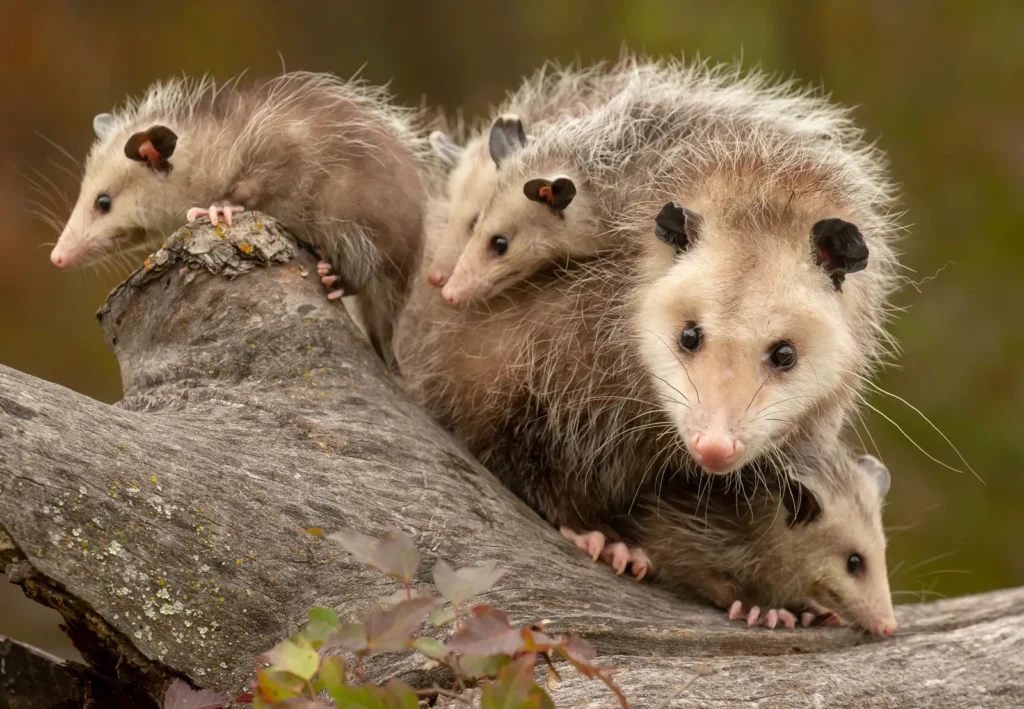
opossums
The world of snake predators is as diverse as it is ruthless, and standing as a testimony to this fact is the unassuming opossum. This nocturnal marsupial, with its shuffling walk and gray fur, may not seem like a formidable snake hunter at first glance. However, its dietary habits and immunity to snake venom tell a different story, one filled with boldness and adaptability.
Read all about: How Big Are Wolves? A Fascinating Size Comparison with Dogs, Humans, and Other Wild Animals
Opossums have a unique ability to consume both venomous and non-venomous snakes, making them a versatile predator in the snake-eating hierarchy. Their immunity to snake venom, much like our spiky friend the hedgehog, allows them to confidently hunt, kill, and consume snake species that other predators might avoid.
Did you know? Opossums have a protein in their blood that neutralizes snake venom, making them immune to the venomous bites of many snake species.
7. Alligators: The Venomous Snake Specialist
The alligator, another reptilian behemoth, holds a special place among snake predators. These aquatic reptiles, with their armored bodies and powerful jaws, are feared by many creatures, snakes included. Alligators exhibit a preference for venomous prey, targeting rattle snakes and cottonmouth snakes with a ruthless efficiency that is fascinating to observe.
Using their sharp teeth and strong jaws, alligators can incapacitate and consume these venomous snakes, unfazed by their potent venom. This preference for venomous snakes is not just a testimony to the alligator’s predatory prowess but also an illustration of the intricate balance of nature, where each creature has a role to play in maintaining the ecosystem.
So, the next time you see an opossum shuffling around or an alligator lurking in the water, remember the important role they play in controlling snake populations, contributing to a balanced and diverse ecosystem.
8. The Majestic Hunters: Hawks
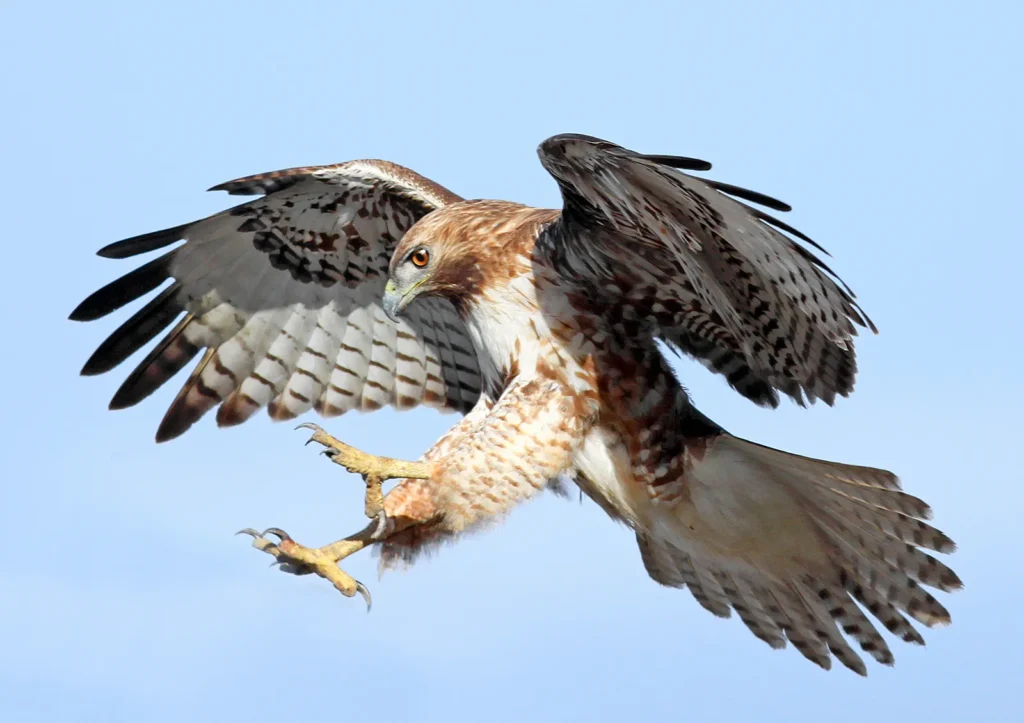
hawk
Among the avian world’s most remarkable predators, the Hawks hold a special place in the food chain as natural adversaries of snakes. Their remarkable ability to hunt and consume snakes cements their critical role in the ecosystem. Particularly, the Red-tailed Hawk, with its distinct brick-red tail, is known for its snake hunting prowess.
Read all about: Are Lions Dangerous? Discover the Truth About Lion Attacks on Humans
Imagine the scene: A red-tailed hawk soaring high in the sky, its keen eyes scanning the ground below. Suddenly, it spots a slithering movement amongst the underbrush. In an instant, it swoops down, its wings folding back for maximum speed. The snake, oblivious to the danger overhead, continues its path. Within seconds, the hawk’s sharp, curved talons close around the unsuspecting snake, its grip unyielding and lethal.
“Most species of hawk, especially the red-tailed hawk, are natural predators of snakes. They use their sharp talons to kill their prey and then eat them.” – Source
These raptors are not only skilled hunters, but they are also perfectly equipped for the task. Their exceptional eyesight allows them to spot potential prey from great heights. Once they have their sights set, their sharp talons become deadly weapons, capable of delivering a fatal blow to the snake.
Furthermore, their beaks, sharp and hooked, are perfectly designed for tearing into the flesh of their captured prey, making the consumption process efficient. It’s a testament to nature’s design that these birds are so well-equipped for their role as snake predators.
Next time you see a hawk circling in the sky, remember that you’re not just looking at a bird. You’re looking at a natural snake predator, a creature that has honed its hunting skills over millions of years and plays a pivotal role in maintaining the balance within our ecosystems.
9. The Powerful Predator: Secretary Birds
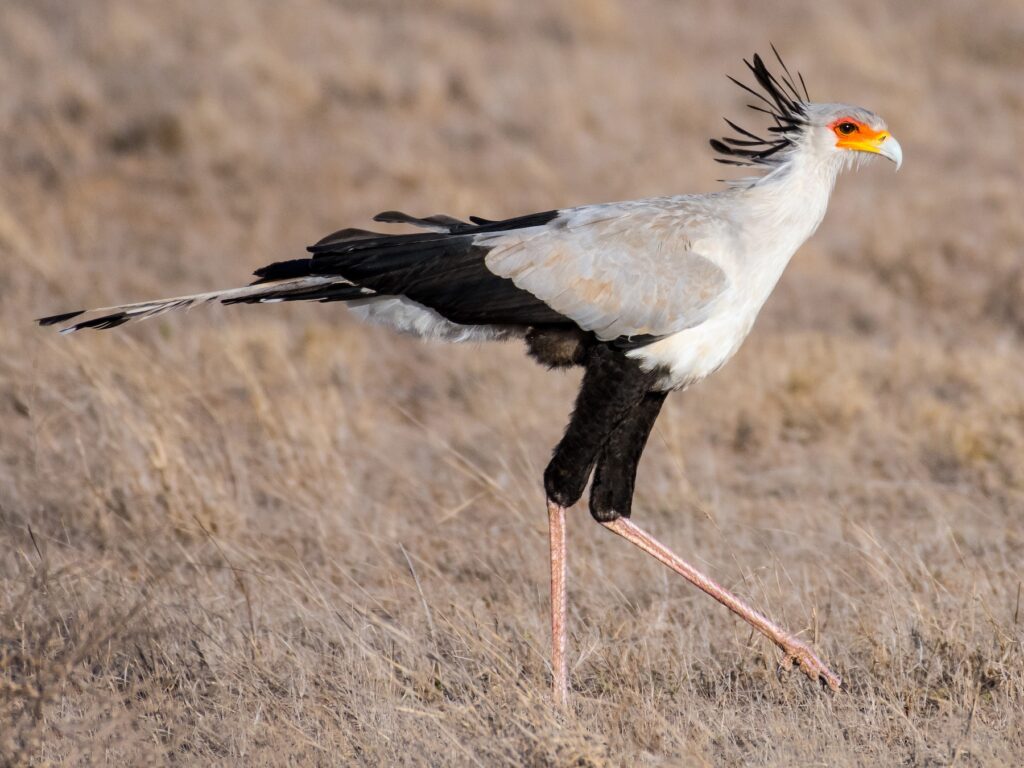
secretary birds
In the vast plains of Africa, a unique bird stands out not only for its peculiar appearance, but also for its remarkable hunting skills. Meet the Secretary Bird, a formidable snake predator that has mastered the art of snake hunting.
Unlike other birds, the Secretary Bird spends most of its time on the ground, using its long, sturdy legs to navigate the sweeping grasslands. These legs, however, are not merely for transportation. They are lethal weapons that the bird uses to stomp on its prey, delivering powerful blows that can kill even the most venomous snakes.
Imagine the scene: a serpentine figure slithers through the tall grass, unaware of the looming threat. Suddenly, a Secretary Bird swoops down, its piercing eyes zeroing in on the unsuspecting snake. With a swift, calculated stomp, the bird incapacitates the snake. The bird’s sharp claws then tear apart the deadly creature.
The Secretary Bird’s unique hunting style and immunity to most snake venoms allow it to face and conquer these dangerous predators. This bird is truly a snake’s nightmare incarnate. Its prominent role in controlling snake populations is a testament to the intricate balance of nature.
The Secretary Bird’s remarkable abilities offer a captivating glimpse into the diverse strategies that snake predators employ to ensure survival. Indeed, the animal kingdom is full of fascinating tales of adaptation and survival, with the Secretary Bird’s story being one of the most intriguing.
10. King Cobra: The Serpent Eating Serpent
Now, let’s delve into an unexpected twist in the snake-eating saga. There exists a predator that is as equally, if not more, feared as its prey. Meet the awe-inspiring King Cobra, a snake that dines on its kin.
Regarded as one of the most dangerous serpents on earth, the King Cobra’s reputation is not merely based on its deadly venom but also its paradoxical dietary preference. Yes, you heard right, this majestic creature predominantly feeds on its fellow snakes.
Picture a squared-off battle between two serpents, both equipped with lethal venom and impressive tactical skills. The King Cobra, however, stands out with its superior size, agility, and unmatched predatory instincts.
Contrary to what one might expect, the King Cobra displays a preference for non-venomous snakes. This choice might be rooted in the lesser risk and energy expenditure associated with subduing non-venomous prey. However, when the need arises, it doesn’t shy away from consuming venomous snakes. This adaptability underscores the King Cobra’s resourcefulness and resilience in the face of survival challenges.
Read all about: “Are Dolphins Truly Friendly? Exploring Their Fascinating Relationship with Humans”
So, while we’ve been exploring the diversity of snake predators, it turns out that snakes themselves play a prominent role in the snake food chain. Such is the irony and complexity of nature’s design.
Next, let’s turn our attention to another fascinating snake predator, one that is known for its fearlessness and tenacity.
11. Honey Badgers: The Tiny Titans of the Animal Kingdom
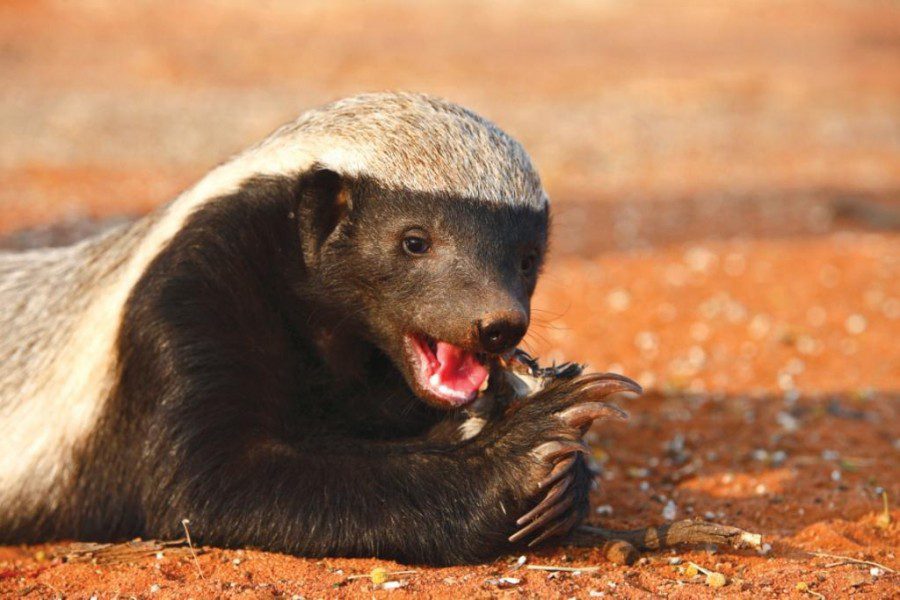
honey badger
As we move further down our list of snake predators, allow me to introduce to you a small yet valiant contender that can give even the most venomous snakes a run for their money. Meet the Honey Badgers, the audacious daredevils of the wild.
These little warriors may not be much larger than a domestic cat, but they possess a fearlessness that is absolutely unmatched. And, they use this courage to prey on a variety of creatures, including snakes, lizards, and even baby alligators.
Imagine a creature so bold and tenacious, it doesn’t hesitate to take on a long, slithering snake. Not only does it stand its ground, but it goes on the offensive, locking its jaws onto the writhing reptile. The Honey Badger’s battle with a snake is not a swift one; it’s a drawn-out display of endurance and strength.
What makes Honey Badgers particularly adept at snake hunting is their incredible resistance to venom. Just as the Secretary Bird and King Cobra possess an immunity to snake venom, so too do these tiny titans. Their body has evolved to neutralize snake venom, allowing them to withstand bites that would be fatal to other creatures.
Equipped with long claws and sharp teeth, Honey Badgers are well-prepared for their encounters with snakes. Their tough skin acts like an armor, giving them an extra layer of protection during their battles with snakes.
In the wild, size does not always correlate with power. The Honey Badger is a perfect example of this, demonstrating that tenacity, courage, and adaptability can overshadow physical dimensions. An encounter with this fearless creature is a daunting prospect for any snake.
12. Tigers: The Striped Snake Hunters
In the diverse culinary spectrum of the animal kingdom, Tigers, the regal striped predators, command a special place. With their impressive hunting skills and adaptability, they do not shy away from adding an occasional snake to their menu. Despite their preference for larger prey such as deer, wild boars, and wild pigs, these majestic creatures are known to consume medium to large-sized snakes when the opportunity presents itself.
Their selection of snake prey varies, but the Black Mambas and Pythons often find themselves on the Tigers’ hit list. Black Mambas, known for their deadly venom, pose a significant threat to many animals, but for Tigers, they are just another potential meal. Pythons, despite their size and strength, are not exempt from this fate either.
Yes, you read that right – Tigers are broad-minded eaters that are not deterred by venom or size when it comes to their diet. This adaptability is a testament to their survival prowess in the wild.
Imagine a Tiger, with its powerful build and piercing gaze, stalking a large python through the dense undergrowth of a tropical jungle. The tension in the air is palpable. With one swift pounce, the Tiger subdues the python, demonstrating the raw power and fearlessness of this apex predator. This might not be a daily spectacle, but it is indeed a sight that underscores the Tiger’s versatility as a predator and its place atop the food chain.
However, it’s crucial to note that snake consumption by Tigers is more opportunistic than habitual. Although capable of tackling venomous serpents, Tigers usually reserve their energy for larger, more filling prey that can satiate their hunger better. But when push comes to shove, or when the regular prey is scarce, snakes can indeed turn into a serpent steak for these big cats.
So, the next time you think of snake predators, remember to include the mighty Tiger in your list. Their occasional indulgence in snakes serves as a fascinating insight into their varied diet and their adaptability in the face of survival.
Snake Predators in Different Habitats: A Battle for Survival
As diverse as the world of snakes is, so too is the variety of their predators. Depending on the habitat, a snake might find itself facing a unique set of threats. It’s a survival game, where adaptation and quick thinking reign supreme.
In the dense and humid rainforests, a snake’s agility and camouflage might be its only defense against a myriad of predators. Here, tigers prowl, their stripes making them almost invisible among the undergrowth. They rely on their strength and speed to overpower their serpentine prey, emphasizing their versatility as hunters. Saltwater crocodiles, on the other hand, wait patiently in the water, using their stealth and powerful jaws to take down unsuspecting snakes.
Birds like the red-tailed hawks and mongooses are also common threats to snakes in these lush habitats. Hawks, with their keen eyesight and swift flight, swoop down to seize snakes before they have a chance to react. Mongooses, small but fearless, are renowned for their snake-fighting abilities, using their agility and resistance to venom to outmaneuver and kill snakes.
Even within their own species, snakes are not safe. The King Cobra, the world’s longest venomous snake, is an ophiophagus (‘snake eater’) that preys on other snakes. Its immunity to the venom of other snakes makes it a formidable predator in the rainforest.
In stark contrast, the arid deserts present a different set of predators. Here, the coyotes and bobcats reign supreme. Using their keen sense of hearing and smell, they can locate and dig out snakes hiding under the sand. Birds of prey, like eagles and hawks, use their sharp vision to spot snakes from the sky, swooping down with deadly precision. The roadrunner, a bird well adapted to desert life, is also a known snake predator, using its speed and agility to avoid snake strikes.
Despite their reputation, snakes are not the apex predators of their environments. They are a significant part of the food web, hunted by a diverse array of predators across different habitats. Their survival depends on their ability to adapt and overcome the challenges each unique environment presents.
Other Creatures in the Dance of the Serpent’s Predation
Just as we’ve explored the dance of survival in the animal kingdom, it’s worth noting that in the grand theater of nature, snakes have more than just the usual suspects as their predators. Picture this: a seemingly innocent house cat, a playful ferret, or even the cunning fox, all of which have been known to kill and devour snakes. This might seem surprising but it is one of the many testaments to the versatility and adaptability of the animal kingdom.
However, one must bear in mind that not all encounters end favourably for these unlikely predators. Particularly for our feline friends, the snake’s venom can be a deadly adversary. While cats may exhibit a natural curiosity and hunting instinct towards snakes, a venomous bite can be dangerous, even fatal.
One of the more unexpected predators of snakes can be a bear. Imagine the sharp contrast between the bear’s size and that of the snake. Yet, on rare occasions, bears are known to consume snakes, showcasing the unpredictability of nature.
It’s not just the animals that can partake in snake consumption. Yes, you’ve read that right. Snake eggs, when cooked properly, can be eaten by us humans. As unexpected as it might sound, it is a culinary practice in some cultures. There’s a lesson here about the interconnectedness of life and the ways in which we are all, in some way or another, part of the intricate web of the food chain.
But let’s not forget, not all animals are snake predators. Herbivores like the majestic moose and insectivores like the quick-footed lizards do not prey on snakes. Similarly, the king of the jungle, the lion, prefers larger game, leaving snakes off their menu.
Understanding these predatory relationships and the food chain not only broadens our knowledge but also helps us appreciate the delicate balance in nature. It serves as a constant reminder that even the creatures we fear, like snakes, have predators of their own. The survival of all creatures, including snakes, is a dance of adaptation and resilience.
Mongooses, crocodiles, hawks, secretary birds, king cobras, tigers, birds such as red-tailed hawks, owls, laughing falcons, and foxes are all common snake predators.
Yes, mongooses are immune to snake venom. Attacks from snakes cause them little to no harm.
Hawks, especially the red-tailed hawk, use their sharp talons to kill and eat snakes.
While tigers occasionally feed on medium to large-sized snakes like black mambas and pythons, their preferred diet consists of animals like deer, wild boars, and wild pigs.

